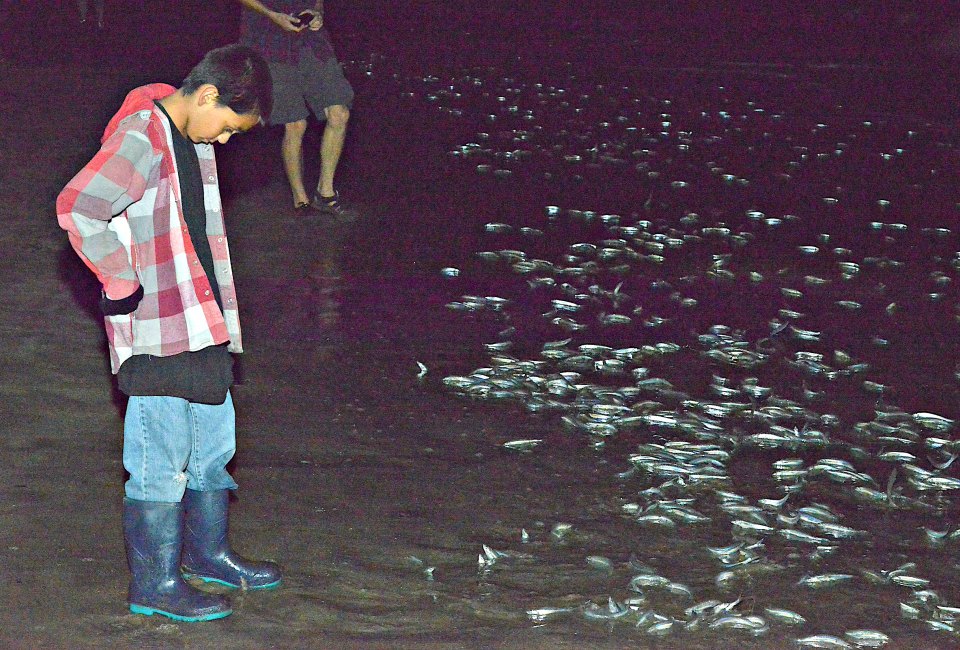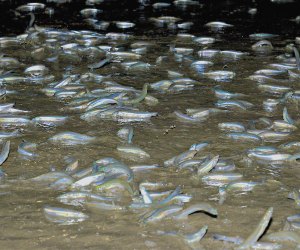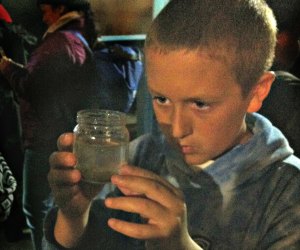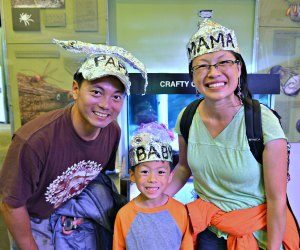Grunion Runs: That SoCal Thing When Thousands of Fish Crawl up the Beach at Midnight

Every once in a while we parents get an opportunity to re-experience a treasured childhood memory with our own kids. If you grew up here in Southern California, odds are that you made it to a grunion run at least once when you were a child. If you're from elsewhere, chances are that you thought this was total urban folklore. Well, it's no myth; there really are SoCal fish that jump out of the ocean at midnight and slither up the beach when the moon is full. The Cabrillo Marine Aquarium in San Pedro has been hosting grunion runs with a front row seat for this peculiar phenomenon since 1964. I remember cooking out on the beach with friends and family, bundled up and waiting for those squirmy silver fish to appear. The hot dogs were usually a bit burnt, and the sand was wet and cold, but it was a night of adventure and marine biology that I never forgot.
OUR LATEST VIDEOS
Many things have changed around LA since then, but the grunion continue to run their way onto the beach, just like in days gone by. If you’ve never been on a grunion run, this is a must do with the kids. It is a very late night, but that's definitely part of the fun. The grunion run from March through July. Like clockwork, they head up the beach after the highest tide on the nights following a full or new moon. Summer is probably the best time to do this, since the beach can get cold so late at night.
During the months of April and May, grunion fans may observe the fish but not touch them. In March, June, and July things get a bit wilder; the grunion can be caught, though only by hand. Kids have free access (and have a squealing good time chasing the amphibious critters in the wet sand!), but anyone over the age of 16 needs a fishing license from the Department of Fish and Wildlife (a great excuse for moms who prefer to stand back and say, "Sorry, I'm just not allowed to run and grab those slimy things...").

Anywhere from a dozen to a thousand fish may wriggle up the beach when the tide turns.
Grunion are small, silvery, sardine-like fish unique to our coast, between Southern California and Baja California. They are one of very few species of fish who lay their eggs on the beach. Their mating ritual is an extraordinary sight: Female grunion wriggle tail first into the sand, after which the males circle them, fertilizing their eggs. Once this process has been completed, the grunion wiggle back into the surf, leaving the eggs to incubate. About 9-10 days later the eggs hatch, when the tide is at its highest again, and the baby grunions ride into the waves to grow and repeat the cycle. On a good night, Cabrillo Beach – which is well situated for a dense run – is blanketed by these silvery fish.
If you want to attempt a grunion run on your own, California Beaches keeps a handy seasonal schedule, based on tides and moon cycles, of which nights and times the grunion may be expected. By far the easier route, though, is to tag along on a guided program.
The Cabrillo Marine Aquarium’s program has not changed since I was a child. On nights when the grunion run, the doors open at 8pm. It is worth arriving at opening time to take advantage of all that the aquarium offers; this is a small but scientifically rich facility that focuses specifically on Southern California’s marine life. There are many displays and hands-on opportunities. The mission of the aquarium is to encourage visitors’ interest in marine biology and ocean conservation. The actual grunion program starts at 9pm and includes a short lecture by a staff member during which questions are encouraged and answered. A wonderful film, Fish, Moon and Tides: The Grunion Story, screens twice nightly. Produced in 1964, this is a brief but informative movie, and, for those of us who saw it as kids, a true trip down memory lane.

The aquarium lets kids hatch grunion babies before their eyes. Photo by Mommy Poppins
After the show, the audience is invited to the aquarium’s patio, where small jars of grunion eggs are distributed. These eggs, collected during the previous run, are ready to hatch when agitated by ocean water. Kids (and parents, too) are invited to shake the eggs and watch them hatch before their very eyes.
And then you wait. Grunion are sensitive and won’t head up to the beach if it is vibrating from crowds of people or brightly lit by flashlights. Aquarium staff ensure that the grunion are ready to begin their ascent to the sand before escorting everyone to the beach. Spectators must arrive quietly in the dark and wait for staff members’ permission to turn on flashlights for the magic moment. On a new moon run, this can mean a very dark 20 minutes or so, but the reveal is worth it. There's no guarantee how many fish will hop out of the waves – it could be anywhere from a handful to a thousand – but once they're up and running, kids can run among them and try to catch them by hand. There is also an opportunity for observation at one of the lab stations set up by aquarium educators along the beach. And once per season the aquarium offers its signature Grunion Fish-tival, with even more activities to accompany the night's run.

Cabrillo Aquarium's family program on grunion run nights is a great introduction to the adventure.
The running of the grunion is a memorable, dramatic, and educational evening, fun for the entire family. Aquarium admission fees are nominal: $5 for adults and $1 for children. Teens and adults who are captivated by the grunion should check out Dr. Karen Martin’s website Grunion.org. And, while the grunion program at the aquarium is terrific and pretty darn cheap, it's also possible to run with the grunion on your own for free (or with a group), if you head down to a beach on the right night.
All photos courtesy of Cabrillo Marine Aquarium unless otherwise noted
Originally published June 17, 2015

























